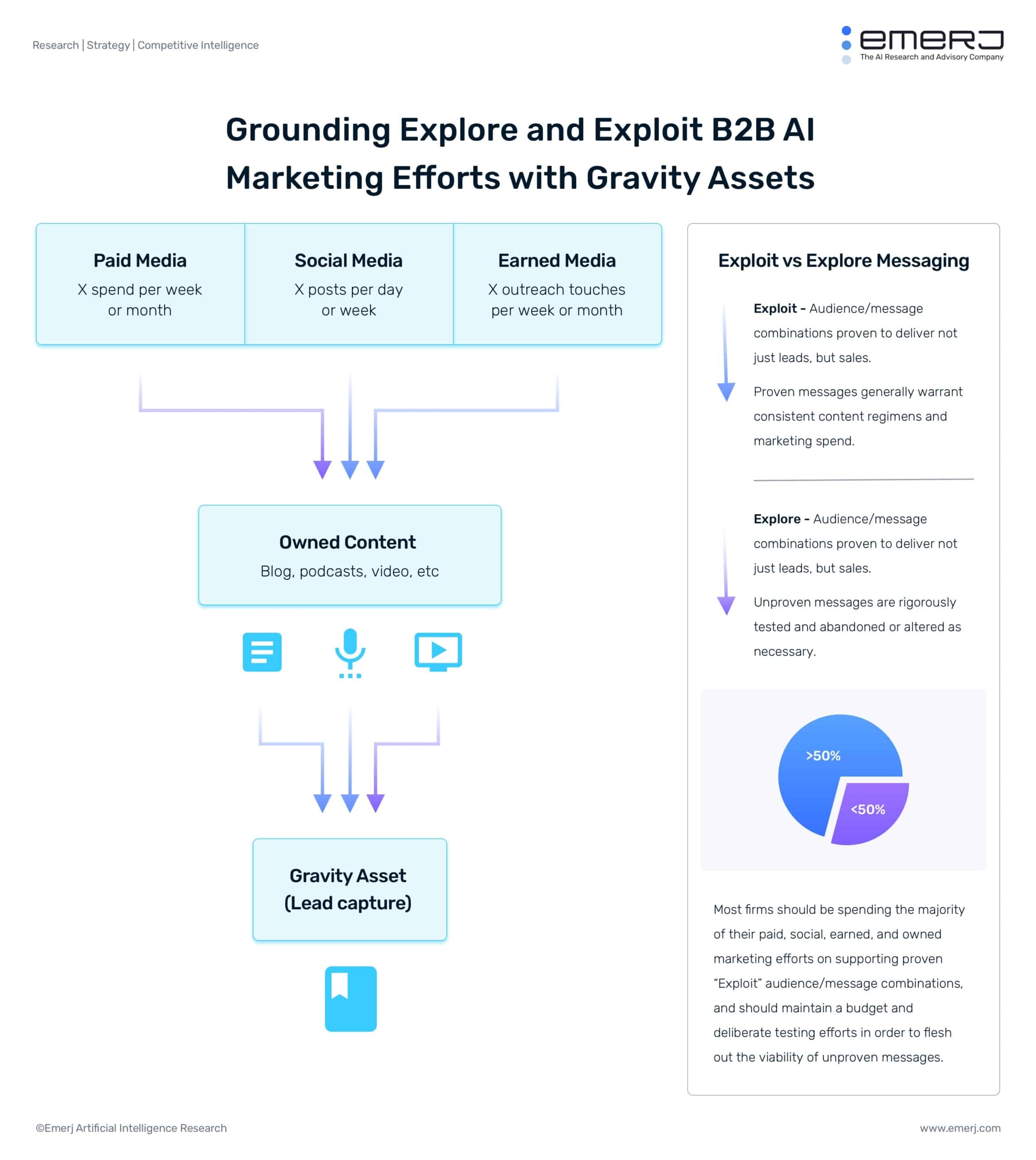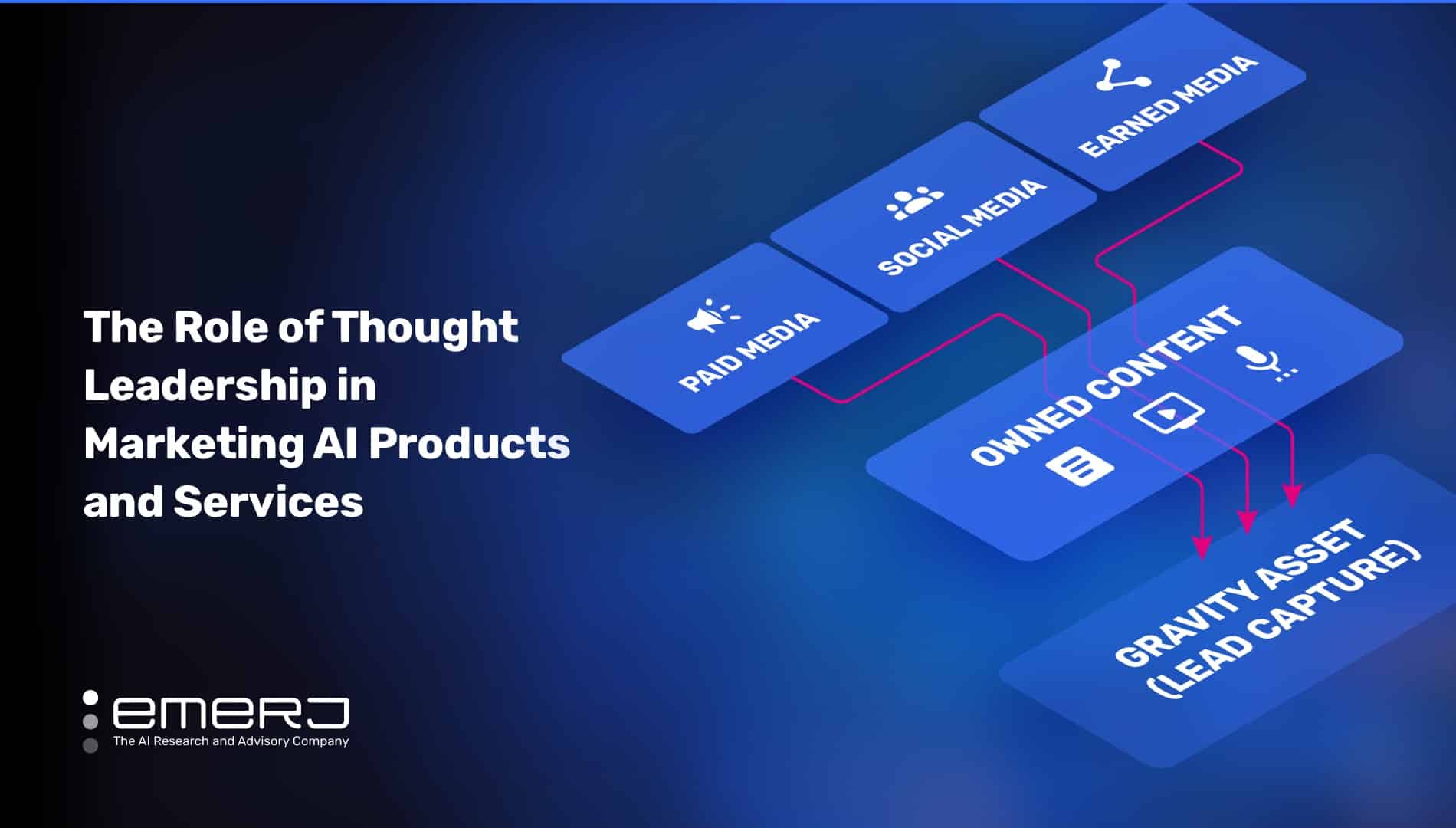In this article, I’ll explore some of our lessons learned in getting the value of AI products or services to stick with enterprise buyers.
If you’re an AI vendor or service provider, this article will help you use thought leadership to help reach your business goals.
If you’re an enterprise AI leader or team member, this article may help you understand what successful vendors do to sell into your organization – and you may apply some of these same ideas to achieve buy-in for AI projects with your own stakeholders.
AI is an “educative” sale.
Managing countless marketing campaigns for our Creative Services clients here at Emerj, I explain it this way:
The goal of AI thought leadership and marketing is to be the one who “turns on prospect’s the light bulb” when it comes to how AI can (a) solve a problem they’re struggling with, or (b) gain an advantage that they want to have.
If you succeed in turning on this light bulb, you’re not guaranteed the sale, but when that prospective client is in the market for your kind of product or service, you’ll likely be one of the first few phone calls they make – giving you an “at bat” to win their business.
AI vendors who do a good job with thought leadership are the vendors who succeed with turning on the light bulb most, and they do that through educative content and thought leadership.
Thought Leadership and Gravity Assets
In our previous Emerj Plus guide titled Developing the Market Message for an AI Product or Service, we talked about developing a marketing message that consistently wins lead sales conversations and new deals. We refer to these hard-won marketing messages as “core messages.”
While most messaging will be of an “explore” nature (i.e. we’re merely experimenting with it, and we aren’t sure if it’ll resonate well in the market), a core message is to be “exploited.”
We recommend that once a firm discovers a core message – they cement their positioning with that message by creating white papers and PDF resources that support this message directly. At Emerj, we refer to these resources as “gravity assets,” as they serve as an anchor to future marketing efforts.
A thought leadership PDF serves a number of important roles:
- An opportunity to cement a core message with a carefully crafted title, sharp design, and strong content
- An opportunity to capture a key attention-oriented theme (core message) with the title and cover, and also an opportunity to convey important positioning-oriented messaging inside the content itself, separating your brand from the competition
- A reason to ask for an email address – PDF downloads provide an excellent online lead-capture tool
- An opportunity to open the eyes of prospective customers
- The ability to lead with education and provide thought leadership value to your desired audience
The length of these “gravity assets” can vary (the thought leadership we create for clients with our Creative Services are usually 5-7, ot 10-15 pages), but the content should generally include the following ingredients:
- Social proof. Whenever possible, include use cases, quotes, and results from actual clients. While a white paper can’t simply be a brag roll, it should sprinkle in a consistent message of credibility. When mentioning a use-case, use a real client whenever possible. Use the client’s name and logo whenever possible. A reader shouldn’t feel interrupted by the inclusion of social proof, but by the time they’re done reading the white paper it should be clear that your company has helped leaders just like them to get results.
- Eye-opening use cases. Highlight the capabilities that AI (and by extension, your product or service) has to benefit the client and to solve their problems. What is the before and after state of the workflow that is impacted – and what are the tangible business outcomes?
- Attraction themes. The title page and introduction section serve the purpose of drawing the business reader in, resonating with the problems or opportunities that are already of blaring importance in their mind.
- Positioning themes. The body of the white paper can integrate some of those differentiating themes and topics that aren’t on a prospect’s mind already, but that you believe help to set your firm apart (a unique approach to data, a proprietary technology, a four-step integration process that helps make your deployments come to life faster, etc).
Many white papers can simply be an introduction that frames the business situation and trends, followed by three or four representative case studies (highlighting, whenever possible, actual clients and actual results).
Exploiting Core Messages with Opt-In Assets and Lead Generation Efforts
After finding a core message and establishing a strong set of PDF thought leadership assets to support them, firms should feel more confident developing a regimen of their own (owned) content initiatives (articles, podcasts, video, etc), as well as external marketing efforts with outside media, earned or paid.
We represent this process in the image below:

It’s possible for a company to have a robust owned, earned, and paid media marketing effort before developing a core message – but these efforts will all be in explore-mode, not exploit-mode, making robust, confident content and marketing efforts challenging.
Once an exploitable core message has been found, marketing leaders and much more confidently commit to a content and marketing regimen. We recommend that at least 50% of owned, earned, or paid media efforts be spent on exploit messaging, with some portion remaining allocated to explore messaging in an attempt to open up more markets and channels for growth.
As shown in the graphic above, we also recommend that companies ensure that their content and media efforts – whether their CEO is getting on someone else’s interview show, or they’re spending their own funds for PPC marketing, or creating blog posts – are spent leading readers towards a download page for a gravity asset. For example:
- Blog posts related to the gravity asset theme should feature links or banners to download the full PDF white paper.
- Interviews of guest articles on other media sources should generally pertain to the core message the company is trying to convey, and should – whenever possible – reference a short URL where readers or listeners can download the full PDF white paper.
- Sponsored content or promotions from other media sources should almost always (a) serve to double down on a core message, and (b) direct traffic to a lead capture page (often, then PDF gravity asset.
We tell our Creative Services clients that “all roads should lead to Rome.”
In other words, once a hard-won core message is discovered, it should be mentioned across all of the media channels we’re investing in (owned, earned, paid, etc), and those various media sources should lead readers to a gravity asset download page where you can capture the prospect’s information, educate the prospect, and present your best attention and positioning-oriented themes in one succinct and useful resource.
AI Brands Grow with Emerj
With over 2,000,000 annual readers, 3,000,000 lifetime podcast downloads and tens of thousands of email subscribers, Emerj.com is a global hub for AI-focused business leaders.
AI product and service firms use Emerj’s wide reach to gain awareness in new marketing through multiple media channels – and firms use Emerj’s research capabilities to create co-branded thought leadership assets.



















